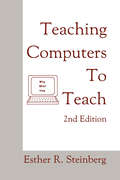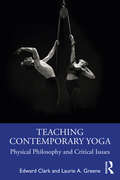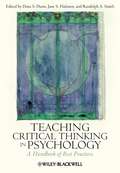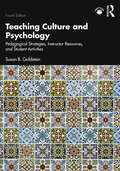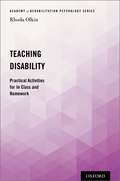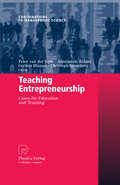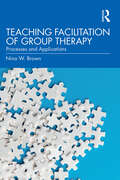- Table View
- List View
Teaching Computers To Teach
by Esther R. SteinbergLike the original version of Teaching Computers to Teach, this updated edition presents procedures and principles for designing computer-presented instruction. It was written as a result of recent developments in three domains that have significant implications for computer-assisted instruction (CAI) and computer-based training (CBT). These areas are audio and videodisc technology, CAI and CBT experience, and research in the processes of learning. This practical book is written specifically for people who want to learn to design CAI. The book presents a CAI-specific design procedure by integrating knowledge about unique aspects of human-machine interaction with theories of learning and instruction as well as practical experience with CAI. The reader is guided through the entire design process, from initial planning to final evaluation, by clearcut principles and concrete examples.
Teaching Contemporary Yoga: Physical Philosophy and Critical Issues
by Edward Clark Laurie A. GreeneTeaching Contemporary Yoga provides a novel look at how modern yoga is understood, practiced, and taught globally. Utilising perspectives from several academic disciplines, the authors offer an analysis of the current state of modern yoga and the possibilities for future experimentation and innovation. The authors draw on anthropological, performance, and embodiment theories to understand yoga practice as a potentially powerful ritual of transformation as well as a cultural product steeped in the process of meaning making. They craft a unique analysis that contrasts asana with the largely unexamined philosophy underlying the practice of vinyasa, while imagining a vibrant future for the evolution of yoga through excellence in teaching. Unlike other writings about yoga, the authors offer a critique of the current practice of yoga as both diminished and utilitarian, while providing a path to reinvigorating the discipline based on current scientific knowledge and methods for teaching and practice. Along with these theoretical perspectives and the analysis of contemporary yoga in the West, the authors offer practical applications to address the challenges of teaching yoga in a society where individualism and materialism are core values. Open-ended exercises in reflection and experimentation offer opportunities for readers to apply what they have learned to their teaching and personal practice. This is a vital guide for any yoga-oriented scholar, teacher, or practitioner and is an essential companion for contemporary teacher training.
Teaching Contemporary Yoga: Physical Philosophy and Critical Issues
by Edward Clark Laurie A. GreeneTeaching Contemporary Yoga provides a novel look at how modern yoga is understood, practiced, and taught globally. Utilising perspectives from several academic disciplines, the authors offer an analysis of the current state of modern yoga and the possibilities for future experimentation and innovation. The authors draw on anthropological, performance, and embodiment theories to understand yoga practice as a potentially powerful ritual of transformation as well as a cultural product steeped in the process of meaning making. They craft a unique analysis that contrasts asana with the largely unexamined philosophy underlying the practice of vinyasa, while imagining a vibrant future for the evolution of yoga through excellence in teaching. Unlike other writings about yoga, the authors offer a critique of the current practice of yoga as both diminished and utilitarian, while providing a path to reinvigorating the discipline based on current scientific knowledge and methods for teaching and practice. Along with these theoretical perspectives and the analysis of contemporary yoga in the West, the authors offer practical applications to address the challenges of teaching yoga in a society where individualism and materialism are core values. Open-ended exercises in reflection and experimentation offer opportunities for readers to apply what they have learned to their teaching and personal practice. This is a vital guide for any yoga-oriented scholar, teacher, or practitioner and is an essential companion for contemporary teacher training.
Teaching Creatively and Teaching Creativity
by Mary Banks Gregerson, James C. Kaufman and Heather T. SnyderCreative teaching as well as teaching creativity are cutting edge issues in psychology today as recent academic and popular media coverage has shown. This volume expands on that interest with chapter authors drawn from interdisciplinary areas. It includes examples of creatively teaching across the education system, including preschool, K-12, undergraduate, and graduate level education. The variety of subjects covered by the chapters include psychology,math, science, and reading. In addition to creative teaching which may lead to enhanced learning and achievement in students, as well enhanced creativity,another focus is teaching with the objective to enhance creativity.
Teaching Critical Psychology: International Perspectives
by Craig Newnes and Laura GoldingThis edited volume may be the 'definitive text' on methods and content in teaching psychology from an international and critical perspective. Chapters from internationally renowned contributors working clinically, educationally and in the community with a range of client groups, outline critical teaching by and for professionals and service recipients. This timely book offers a unique, research-based and philosophically coherent approach to teaching psychology including teaching methods, the lecture content of radical approaches to modern psychology and debates as to whether the aim of teaching is to liberate or control. Themes include the nature of pedagogy, the importance of teaching and learning style, the relevance of context and content and the ways in which traditional teaching forms a part of the disciplinary rather than critical project. Teaching Critical Psychology offers guidance in teaching pupils, students, peers and those on academic programmes at under-graduate and post-graduate level.
Teaching Critical Psychology: International Perspectives
by Craig Newnes Laura GoldingThis edited volume may be the 'definitive text' on methods and content in teaching psychology from an international and critical perspective. Chapters from internationally renowned contributors working clinically, educationally and in the community with a range of client groups, outline critical teaching by and for professionals and service recipients. This timely book offers a unique, research-based and philosophically coherent approach to teaching psychology including teaching methods, the lecture content of radical approaches to modern psychology and debates as to whether the aim of teaching is to liberate or control. Themes include the nature of pedagogy, the importance of teaching and learning style, the relevance of context and content and the ways in which traditional teaching forms a part of the disciplinary rather than critical project. Teaching Critical Psychology offers guidance in teaching pupils, students, peers and those on academic programmes at under-graduate and post-graduate level.
Teaching Critical Thinking in Psychology: A Handbook of Best Practices
by Dana S. Dunn Jane S. Halonen Randolph A. SmithTeaching Critical Thinking in Psychology features current scholarship on effectively teaching critical thinking skills at all levels of psychology. Offers novel, nontraditional approaches to teaching critical thinking, including strategies, tactics, diversity issues, service learning, and the use of case studies Provides new course delivery formats by which faculty can create online course materials to foster critical thinking within a diverse student audience Places specific emphasis on how to both teach and assess critical thinking in the classroom, as well as issues of wider program assessment Discusses ways to use critical thinking in courses ranging from introductory level to upper-level, including statistics and research methods courses, cognitive psychology, and capstone offerings
Teaching Culture and Psychology: Pedagogical Strategies, Instructor Resources, and Student Activities
by Susan B. GoldsteinThe fourth edition of Teaching Culture and Psychology (previously Cross-Cultural Explorations) provides an array of carefully designed instructor resources and student activities that support the construction and implementation of courses on culture and psychology.Revised and expanded from previous editions, the book enables instructors to use selected activities appropriate for their course structure. Part One explores a variety of pedagogical challenges involved in teaching about culture and psychology and details specific strategies for addressing these challenges. Part Two (instructor resources) and Part Three (student handouts) center around 90 activities designed to encourage students to think critically about the role of culture in a wide range of psychology content areas. These activities are based on current and classic cross-cultural research and take the form of case studies, self-administered scales, mini-experiments, database search assignments, and the collection of content-analytic, observational, and interview data. For each activity, instructors are provided with a lecture/discussion module as well as suggestions for variations and expanded writing assignments. Student handouts are available in this text as well as on the Routledge website as fillable forms.Contributing to the inclusion of cultural perspectives in the psychology curriculum, this wide-ranging book enables instructors to provide students with hands-on experiences that facilitate the understanding and application of major concepts and principles in the study of culture and psychology, making it ideal for cultural psychology, anthropology, sociology, and related courses.
Teaching Culture and Psychology: Pedagogical Strategies, Instructor Resources, and Student Activities
by Susan B. GoldsteinThe fourth edition of Teaching Culture and Psychology (previously Cross-Cultural Explorations) provides an array of carefully designed instructor resources and student activities that support the construction and implementation of courses on culture and psychology.Revised and expanded from previous editions, the book enables instructors to use selected activities appropriate for their course structure. Part One explores a variety of pedagogical challenges involved in teaching about culture and psychology and details specific strategies for addressing these challenges. Part Two (instructor resources) and Part Three (student handouts) center around 90 activities designed to encourage students to think critically about the role of culture in a wide range of psychology content areas. These activities are based on current and classic cross-cultural research and take the form of case studies, self-administered scales, mini-experiments, database search assignments, and the collection of content-analytic, observational, and interview data. For each activity, instructors are provided with a lecture/discussion module as well as suggestions for variations and expanded writing assignments. Student handouts are available in this text as well as on the Routledge website as fillable forms.Contributing to the inclusion of cultural perspectives in the psychology curriculum, this wide-ranging book enables instructors to provide students with hands-on experiences that facilitate the understanding and application of major concepts and principles in the study of culture and psychology, making it ideal for cultural psychology, anthropology, sociology, and related courses.
Teaching Deaf Learners: Psychological and Developmental Foundations (Perspectives on Deafness)
by Harry Knoors Marc MarscharkTeaching Deaf Learners: Psychological and Developmental Foundations explores how deaf students (children and adolescents) learn and the conditions that support their reaching their full cognitive potential -- or not. Beginning with an introduction to teaching and learning of both deaf and hearing students, Knoors and Marschark take an ecological approach to deaf education, emphasizing the need to take into account characteristics of learners and of the educational context. Building on the evidence base with respect to developmental and psychological factors in teaching and learning, they describe characteristics of deaf learners which indicate that teaching deaf learners is not, or should not, be the same as teaching hearing learners. In this volume, Knoors and Marschark explore factors that influence the teaching of deaf learners, including their language proficiencies, literacy and numeracy skills, cognitive abilities, and social-emotional factors. These issues are addressed in separate chapters, with a focus on the importance to all of them of communication and language. Separate chapters are devoted to the promise of multimedia enhanced education and the possible influences of contextual aspects of the classroom and the school on learning by deaf students. The book concludes by pointing out the importance of appropriate education of teachers of deaf learners, given the increasing diversity of those students and the contexts in which they are educated. It bridges the gap between research and practice in teaching and outlines ways to improve teacher education.
Teaching Deaf Learners: Psychological and Developmental Foundations (Perspectives on Deafness)
by Marc Marschark Harry KnoorsTeaching Deaf Learners: Psychological and Developmental Foundations explores how deaf students (children and adolescents) learn and the conditions that support their reaching their full cognitive potential -- or not. Beginning with an introduction to teaching and learning of both deaf and hearing students, Knoors and Marschark take an ecological approach to deaf education, emphasizing the need to take into account characteristics of learners and of the educational context. Building on the evidence base with respect to developmental and psychological factors in teaching and learning, they describe characteristics of deaf learners which indicate that teaching deaf learners is not, or should not, be the same as teaching hearing learners. In this volume, Knoors and Marschark explore factors that influence the teaching of deaf learners, including their language proficiencies, literacy and numeracy skills, cognitive abilities, and social-emotional factors. These issues are addressed in separate chapters, with a focus on the importance to all of them of communication and language. Separate chapters are devoted to the promise of multimedia enhanced education and the possible influences of contextual aspects of the classroom and the school on learning by deaf students. The book concludes by pointing out the importance of appropriate education of teachers of deaf learners, given the increasing diversity of those students and the contexts in which they are educated. It bridges the gap between research and practice in teaching and outlines ways to improve teacher education.
Teaching Dementia Care: Skill and Understanding
by Nancy L. MaceDementia afflicts millions of Americans and deeply affects the lives of their loved ones. Good care has been proven to have a significant effect on the quality of life of a person with dementia. To ensure good care, staff members of nursing homes, assisted living facilities, and adult day-care centers, and providers of home care must be thoroughly and continually trained by qualified and well-prepared professionals.Nancy L. Mace, coauthor of The 36-Hour Day, has created the ultimate teachers' guide for dementia care training. Rich with information and with tools for effective communication between teacher and student, the text supplies instructors with in-depth lessons and includes relevant charts, tables, and handouts, which may be customized to suit specific programs. Good training is the foundation for a confident and competent caregiver and supports the dignity and well-being of persons with dementia and their families. With her unmistakable compassion, humor, and wisdom, Mace has provided a much-needed guidebook for better teaching and better care.
Teaching Disability: Practical Activities for In Class and Homework (Academy of Rehabilitation Psychology Series)
by Rhoda OlkinThis book takes a nonpathological approach to disability, viewing it as part of diversity rather than as deficit. The opening chapters introduce basic knowledge of teaching in disability communities, covering attitudes and behaviors that may be difficult for instructors to relate to. Next, the book delves into the three activities sections that increase in difficulty over the course of the book. The activities highlight barriers and psychosocial impediments that hamper progress in disability communities. Designed by an expert educator and clinician who is also an insider in the disability community, each of the 34 activities translate well in classroom environments or as homework, and each can be done individually or in group settings. All activities include a list of required materials, time expectation, goal setting criteria, possible outcomes, and talking and debriefing points for reflection, thereby facilitating effective planning and execution. The activities also recommend possible modifications to adjust the difficulty of the activities. This flexibility makes this a valuable resource for a wider audience of expertise and settings, ranging from introductory to sophisticated readers and users, students and non-students, in classrooms, in workshops, or in other surroundings. Lastly, the book concludes with a chapter on accessing outcomes, with six measures for evaluating knowledge and skill. Teaching Disability is a well-rounded, highly applicable tool for instructors and students in the disability community.
Teaching Disability: Practical Activities for In Class and Homework (Academy of Rehabilitation Psychology Series)
by Rhoda OlkinThis book takes a nonpathological approach to disability, viewing it as part of diversity rather than as deficit. The opening chapters introduce basic knowledge of teaching in disability communities, covering attitudes and behaviors that may be difficult for instructors to relate to. Next, the book delves into the three activities sections that increase in difficulty over the course of the book. The activities highlight barriers and psychosocial impediments that hamper progress in disability communities. Designed by an expert educator and clinician who is also an insider in the disability community, each of the 34 activities translate well in classroom environments or as homework, and each can be done individually or in group settings. All activities include a list of required materials, time expectation, goal setting criteria, possible outcomes, and talking and debriefing points for reflection, thereby facilitating effective planning and execution. The activities also recommend possible modifications to adjust the difficulty of the activities. This flexibility makes this a valuable resource for a wider audience of expertise and settings, ranging from introductory to sophisticated readers and users, students and non-students, in classrooms, in workshops, or in other surroundings. Lastly, the book concludes with a chapter on accessing outcomes, with six measures for evaluating knowledge and skill. Teaching Disability is a well-rounded, highly applicable tool for instructors and students in the disability community.
Teaching Economics: Perspectives on Innovative Economics Education
by Joshua Hall Kerianne LawsonThis book looks at a number of topics in economic education, presenting multiple perspectives from those in the field to anyone interested in teaching economics. Using anecdotes, classroom experiments and surveys, the contributing authors show that, with some different or new techniques, teaching economics can be more engaging for students and help them better retain what they learned. Chapters cover a wide range of approaches to teaching economics, from interactive approaches such as utilizing video games and Econ Beats, to more rigorous examinations of government policies, market outcomes and exploring case studies from specific courses. Many of the chapters incorporate game theory and provide worked out examples of games designed to help students with intuitive retention of the material, and these games can be replicated in any economics classroom. While the exercises are geared towards college-level economics students, instructors can draw inspiration for course lectures from the various approaches taken here and utilize them at any level of teaching. This book will be very useful to instructors in economics interested in bringing innovative teaching methods into the classroom.
Teaching Empathy: Strategies for Building Emotional Intelligence in Today's Students
by Suzanna E. HenshonAs classrooms become more diverse, it is increasingly important that students learn how to empathize with others who may come from very different backgrounds. Teaching Empathy:
Teaching Empathy: Strategies for Building Emotional Intelligence in Today's Students
by Suzanna E. HenshonAs classrooms become more diverse, it is increasingly important that students learn how to empathize with others who may come from very different backgrounds. Teaching Empathy:
Teaching Empathy in Healthcare: Building a New Core Competency
by Adriana E. Foster Zimri S. YaseenEmpathy is essential to effectively engaging patients as partners in care. Clinicians’ empathy is increasingly understood as a professional competency, a mode and process of relating that can be learned and taught. Communication and empathy training are penetrating healthcare professions curricula as knowledge about the most effective modalities to train, maintain, and deepen empathy grows. This book draws on a wide range of contributors across many disciplines, and takes an evidence-based and longitudinal approach to clinical empathy education. It takes the reader on an engaging journey from understanding what empathy is (and how it can be measured), to approaches to empathy education informed by those understandings. It elaborates the benefits of embedding empathy training in graduate and post-graduate curricula and the importance of teaching empathy in accord with the clinician’s stage of professional development. Finally, it examines systemic perspectives on empathy and empathy education in the clinical setting, addressing issues such as equity, stigma, and law. Each section is full of the latest evidence-based research, including, notably, the advances that have been made over recent decades in the neurobiology of empathy.Perspectives among the interdisciplinary chapters include: Neurobiology of empathy Measuring empathy in healthcare Teaching clinicians about affect Teaching cultural humility: Understanding the core of others by reflecting on ours Empathy and implicit bias: Can empathy training improve equity? Teaching Empathy in Healthcare: Building a New Core Competency takes an innovative and comprehensive approach towards a developed understanding of empathy in the clinical context. This evidence-based book is set to become a classic text on the topic of empathy in healthcare settings, and will appeal to a broad readership of clinicians, educators, and researchers in clinical medicine, neuroscience, behavioral health, and the social sciences, leaders in educational and professional organizations, and anyone interested in the healthcare services they utilize.
Teaching English for Academic Purposes: Studies from an English-medium University (English Language Education #14)
by Rachael Ruegg Clay WilliamsThis book focuses on appropriate English for Academic Purposes instructional concepts and methods in the Japanese context. It investigates a variety of pedagogical techniques, addressing the fundamental academic English skills – listening, speaking, reading and writing – as well as assessment and materials development. All the research included was conducted in Japanese university settings, thus shedding new light on the effective implementation of EAP teaching and learning activities with Japanese learners of English. This book is of interest to anyone working in an EAP context at the secondary or tertiary level, especially those which include Japanese learners.
Teaching Entrepreneurship: Cases for Education and Training (Contributions to Management Science)
by Peter Van Der Sijde Annemarie Ridder Gerben Blaauw Christoph Diensberg“Entrepreneurship that is something you learn in practice”. “Entreprene- ship is learning by doing”. This is often heard when you tell others that you teach entrepreneurship, but maybe entrepreneurship is more “doing by learning”. Nevertheless, in entrepreneurship practice and theory are int- woven. For this reason the Learning Cycle introduced by Kolb (1984) is an often used teaching approach. According to this Learning Cycle there are four phases (“cycle”) that are connected: 1. Concrete experience (“doing”, “experiencing”) 2. Reflection (“reflecting on the experience”) 3. Conceptualization (“learning from the experience”) 4. Experimentation (“bring what you learned into practice”) In teaching you can enter this cycle at any stage, depending on the students. And that brings us to the different types of students. Based on Hills et al. (1998) a plethora of student groups can be distinguished (of course this list is not exhaustive), e.g: Ph.D. students, who do a doctoral programme in Entrepreneurship; the emphasis is on theory/science. DBA students, who do a doctoral programme that is, in comparison to the Ph.D. more practice oriented. MBA students, who take entrepreneurship as one of the courses in their programme. Most of the time MBA students are mature students, who after some work experience return to the university; the programme is practice oriented.
Teaching Facilitation of Group Therapy: Processes and Applications
by Nina W. BrownTeaching Facilitation of Group Therapy explores an extensive range of topics crucial to effective teaching and practice, and will be a valuable resource for instructors of group therapy. With an emphasis on evidence-based methodologies, this book describes proven teaching techniques that foster a dynamic learning environment, facilitate group cohesion, and promote meaningful interventions. The author presents ethical considerations including those that relate to using social media in therapeutic practices, equipping readers with the knowledge to leverage its potential while safeguarding client confidentiality and well-being. This resource presents topics including therapeutic factors and effective interventions, the use of the group leader’s inner development as a guide for therapeutic alliance and group members’ healing, cutting-edge therapeutic AI applications, the role of self-absorption for members and the leader, group dynamics, ethical uses of social media in therapeutic settings, and serves as a comprehensive guide for instructors in the art of teaching group psychotherapy in the modern era. This is an indispensable resource for educators to elevate their expertise in teaching group psychotherapy and prepare clinicians and students by deepening their understanding of group dynamics, and how to employ effective interventions that promote healing and growth in therapeutic settings.
Teaching Facilitation of Group Therapy: Processes and Applications
by Nina W. BrownTeaching Facilitation of Group Therapy explores an extensive range of topics crucial to effective teaching and practice, and will be a valuable resource for instructors of group therapy. With an emphasis on evidence-based methodologies, this book describes proven teaching techniques that foster a dynamic learning environment, facilitate group cohesion, and promote meaningful interventions. The author presents ethical considerations including those that relate to using social media in therapeutic practices, equipping readers with the knowledge to leverage its potential while safeguarding client confidentiality and well-being. This resource presents topics including therapeutic factors and effective interventions, the use of the group leader’s inner development as a guide for therapeutic alliance and group members’ healing, cutting-edge therapeutic AI applications, the role of self-absorption for members and the leader, group dynamics, ethical uses of social media in therapeutic settings, and serves as a comprehensive guide for instructors in the art of teaching group psychotherapy in the modern era. This is an indispensable resource for educators to elevate their expertise in teaching group psychotherapy and prepare clinicians and students by deepening their understanding of group dynamics, and how to employ effective interventions that promote healing and growth in therapeutic settings.
Teaching Family Therapy (The Systemic Thinking and Practice Series)
by Ros Draper Myrna Gower Clare HuffingtonThe teaching of family therapy has been the subject of serious scrutiny since the onset of training and accreditation many years ago, yet there are relatively few attempts to apply what we know about systems and the ways they change family therapy teaching as a two-way process. It is as though family therapy teachers were preoccupied with the content of what should be taught, and were not able to direct their attention to the process by which people learned. The authors began by describing the way they conceptualize the "learning context" which sets the frame for all the teaching they do. Then they discuss the process of setting up a family therapy course, e.g. "What is the best way to negotiate with a training officer to set up a course in a local area?". The book then moves to creating the course syllabus, and some of the practical problems-from lateness to mechanical failures-of getting the course off the ground.
Teaching Family Therapy (The Systemic Thinking and Practice Series)
by Ros Draper Myrna Gower Clare Huffington Rosemary WhiffenThe teaching of family therapy has been the subject of serious scrutiny since the onset of training and accreditation many years ago, yet there are relatively few attempts to apply what we know about systems and the ways they change family therapy teaching as a two-way process. It is as though family therapy teachers were preoccupied with the content of what should be taught, and were not able to direct their attention to the process by which people learned. The authors began by describing the way they conceptualize the "learning context" which sets the frame for all the teaching they do. Then they discuss the process of setting up a family therapy course, e.g. "What is the best way to negotiate with a training officer to set up a course in a local area?". The book then moves to creating the course syllabus, and some of the practical problems-from lateness to mechanical failures-of getting the course off the ground.
Teaching for Creativity: Super-charged learning through 'The Invisible Curriculum'
by Andrew HammondThe Invisible Curriculum Series gives teachers the secret ingredients to unlock the full potential of children's learning abilities. Too often in formal schooling, creativity and curiosity are taught out of children. Teaching for Creativity offers practical advice on how to ensure that this does not happen. This book will help teachers to preserve children's innate creative capacities at the same time as maintaining academic standards in the classroom.
